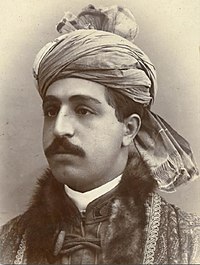Ayub Khan (Emir of Afghanistan)
| Mohammad Ayub Khan | |||||
|---|---|---|---|---|---|
| Emir of Afghanistan | |||||
 Ghazi Mohammad Ayub Khan | |||||
| Emir of Afghanistan | |||||
| Reign | October 12, 1879 – May 31, 1880 | ||||
| Predecessor | Mohammad Yaqub Khan | ||||
| Successor | Abdur Rahman Khan | ||||
| Born | 1857 Kabul, Afghanistan | ||||
| Died | April 7, 1914 (aged 56–57) Lahore, present-day Pakistan | ||||
| Burial | 1914 | ||||
| |||||
| Dynasty | Barakzai dynasty | ||||
| Father | Sher Ali Khan | ||||
| Mother | Momand | ||||
Ghazi Mohammad Ayub Khan (Pashto: غازي محمد ايوب خان) (1857 – April 7, 1914, Urdu: غازی محمد ایوب خان) was also known as The Victor of Maiwand or The Afghan Prince Charlie and was, for a while, the governor of Herat Province in Afghanistan. He was Emir of Afghanistan from October 12, 1879 to May 31, 1880[1][2] and was also the leader of Afghans in the Second Anglo-Afghan War. He is today remembered as National Hero of Afghanistan and is buried in Peshawar.[3]
Early life
His father was Sher Ali Khan and his mother was the daughter of an influential Mohmand chief of Lalpura, Saadat Khan.[4]
Second Anglo-Afghan war
On July 27, 1880, inspired by the battle songs of Malalai of Maiwand in support of the freedom fighters, he defeated the British Army of George Burrows at the Battle of Maiwand. This was the biggest defeat for the Anglo-Indian army in the second Anglo-Afghan war. He went on to besiege the superiourly equipped British forces at Kandahar but did not succeed. On September 1, 1880, he was defeated and routed by forces led by General Frederick Roberts at the Battle of Kandahar, which saw the end of the Second Anglo-Afghan War.[4]
After second Anglo-Afghan war
A year later Ayub again tried to take Kandahar, this time from Amir Abdur Rahman Khan but again failed.
- "Ayub Khan had an opportunity of realizing his strength as an independent ruler in Afghanistan [sic]. Certain tribes in Kushk district having revolted, he desired to send a force from Herat to punish them; but when he asked his men to march they refused, because he had not paid them for a long time." From The Twillingate Sun, Thursday, February 3, 1881.
He escaped to Persia (now Iran). After negotiations in 1888 with Sir Mortimer Durand, the ambassador at Teheran, Ayub Khan became a pensioner of the British Raj. A political officer, William Evans-Gordon, took charge of him on his arrival in India and escorted him with his entourage from Karachi to Rawalpindi.[5] He lived in India until his death in 1914.
Death and legacy
He is today remembered as National Hero of Afghanistan and his body was interred near the shrine of Sheikh Habib at Durrani graveyard in Peshawar. His mausoleum was vandalized and his tomb tablet stolen. Efforts are being made by one of his family members, Asim Khan Effendi to reconstruct and restore the monument in consultation with cultural conservationalist of International repute Hameed Haroon and leading Architect Mujeeb Khan.
References
- ^ Hamid. "Afghanistan Monarchs". afghanistantourism.net. Retrieved 2011-07-14.
- ^ Wahid Momand. "Leaders". Afghanland.com. Retrieved 2011-07-14.
- ^ various. "Cities". The Columbia Encyclopedia, 6th ed.
- ^ a b Chisholm 1911.
- ^ Skelton & Bulloch 1912, p. 395.
- Sources
- Skelton, Constance Oliver; Bulloch, John Malcolm (1912). Gordons under Arms: A Biographical Muster Roll of Officers named Gordon in the Navies and Armies of Britain, Europe, America and in the Jacobite Risings. Aberdeen University Studies No. 59. Aberdeen: Printed for the University.
{{cite book}}: Invalid|ref=harv(help)
- Attribution
Chisholm, Hugh, ed. (1911). . Encyclopædia Britannica (11th ed.). Cambridge University Press.
External links
- Relic hunters rob gravestone of Sardar Ayub Khan (The News, 7th June 2010)[permanent dead link]
- Relics stolen from graveyard still untraced (The News, 10th June 2010)[permanent dead link]
- Here lies the Victor of Maiwand by Dr. Ali Jan
